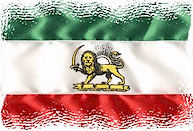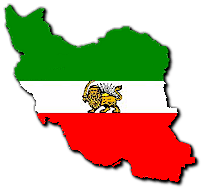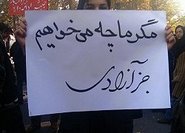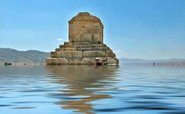Alliance For democracy In Iran
Please have a look at my other weblog, Iran Democracy - http://irandemocray.blogspot.com/
IMPERIAL EMBLEM

PERSIA
Shahanshah Aryameher
S U N OF P E R S I A
Iranian Freedom Fighters UNITE
Wednesday, August 15, 2007
Iran Blacks Out Day Of Protest : Amir Taheri
August 14, 2007 New York Post
'NO news is good news," goes the old adage. But one man's good news can be another's bad news - or, if the authorities have their way, not be allowed to be news at all. Consider reporting from the Islamic Republic of Iran. For Iran's authorities, last Thursday brought bad news: demonstrations throughout the country in support of jailed union leaders and labor activists. In Tehran, hundreds gathered near the home of Mansour Osanloo, the imprisoned leader of the capital's transit workers, with a simple message: We are not afraid! The authorities had organized a military operation to cordon off the streets leading to the house - but couldn't prevent union members from assembling. The day ended with the arrest of at least 15 workers' leaders. Meanwhile, in factories and workshops in and around the capital, workers organized peaceful hour-long "solidarity pauses," defying a ban imposed by the authorities. Several other major cities saw similar demonstrations, including Ahvaz, Arak, Sanandaj, Shiraz and Tabriz. Everywhere, the protesters took care to keep their actions within the law. Yet the authorities kept any mention of Thursday's events out of the official media. That the mullahs should treat this as "not news" is no surprise. For years, they have pretended to be working on behalf of Iran's poorest working masses - but now the mask is falling. It is precisely those poorest working masses that present the regime with its biggest challenge. What is surprising is that much of the global media should also regard this bad news for the mullahs as no news. According to the Ministry of Islamic Orientation and Culture in Tehran, 117 registered foreign media correspondents work in Iran. Yet (except for a stringer for a Japanese news agency who appeared at a demonstration in a car factory near Tehran) none paid attention to the workers' day of solidarity. Osanloo's lawyers phoned the offices of more than a dozen Western news agencies and radio and TV networks in Tehran in the hope of persuading them to cover the events - with no results. Inside Iran, some see global conspiracy to keep international opinion in the dark about what is really happening in the Islamic Republic. They ask: Why is it that world media representatives in Iran never interview any of the thousands of trade unionists, teachers' leaders, journalists, student activists, women's-lib militants and dissident intellectuals? Why is the brutal repression in several provinces, which has already claimed scores of lives, never covered on the spot? The authorities admit they've arrested almost a million people in the last four months, keeping them for anything from several hours to several weeks. Yet the news from Iran is focused on the mullahs' defiance of the U.N. on the nuclear issue. There is no conspiracy; the global media's silence on Iran's internal turmoil can be explained by three facts: * Some Western editors are sympathetic to the Islamic Republic, which they see as a plucky Third World regime standing up against Western, especially American, "Imperialist bullying." * Tehran refuses to admit the representatives of media outlets it regards as "hostile." As President Mahmoud Ahmadinejad indicated last week in his visit to the Islamic Republic News Agency's headquarters in Tehran, information is allowed only if it serves "the interests of our revolution." It is only after long negotiations that Iran's government allows foreign, especially Western, media to open offices and have correspondents in Tehran, on the implicit understanding that the concerned outlet keeps its coverage within limits fixed by the authorities. * Correspondents and stringers working for Western media in Iran are under constant psychological and, at times, even physical pressure. If they are expatriates, they could find it impossible to get a place to rent or to obtain an air ticket to a provincial capital. If unhappy with the coverage, official sources may suddenly boycott the correspondent. The renewal of residence and work permits provide bi-annual occasions for the authorities to intimidate foreign correspondents. Foreign media representatives could be seized and held hostage, as was the case with The Wall Street Journal's Gerald Seib and is currently the case with Radio Free Europe's Parnaz Azima. Right now, at least 11 Iranian journalists are in prison on charges of unauthorized cooperation with foreign media. Even at best, foreign correspondents, most of whom don't speak Persian, remain dependent on interpreters and minders from the Ministry of Islamic Orientation and Culture. The Islamic Republic is certainly not the first to keep a tight leash on foreign media. It was on similar terms that Saddam Hussein allowed a handful of foreign correspondents to stay in Iraq. The good news, however, is that, thanks to the Internet and other means of communication, information almost always ends up getting out. The real news from Iran is the struggle between those who believe that only freedom, pluralism and peace can save the country and those who wish to erect a wall around the Islamic Republic and prepare it for war. As the nation moves toward elections in 10 months' time, the struggle is likely to sharpen with the future of the country in the balance. The outside world had better pay attention. For what is known as "the Iran problem" can only be solved inside the country by its people.
'NO news is good news," goes the old adage. But one man's good news can be another's bad news - or, if the authorities have their way, not be allowed to be news at all. Consider reporting from the Islamic Republic of Iran. For Iran's authorities, last Thursday brought bad news: demonstrations throughout the country in support of jailed union leaders and labor activists. In Tehran, hundreds gathered near the home of Mansour Osanloo, the imprisoned leader of the capital's transit workers, with a simple message: We are not afraid! The authorities had organized a military operation to cordon off the streets leading to the house - but couldn't prevent union members from assembling. The day ended with the arrest of at least 15 workers' leaders. Meanwhile, in factories and workshops in and around the capital, workers organized peaceful hour-long "solidarity pauses," defying a ban imposed by the authorities. Several other major cities saw similar demonstrations, including Ahvaz, Arak, Sanandaj, Shiraz and Tabriz. Everywhere, the protesters took care to keep their actions within the law. Yet the authorities kept any mention of Thursday's events out of the official media. That the mullahs should treat this as "not news" is no surprise. For years, they have pretended to be working on behalf of Iran's poorest working masses - but now the mask is falling. It is precisely those poorest working masses that present the regime with its biggest challenge. What is surprising is that much of the global media should also regard this bad news for the mullahs as no news. According to the Ministry of Islamic Orientation and Culture in Tehran, 117 registered foreign media correspondents work in Iran. Yet (except for a stringer for a Japanese news agency who appeared at a demonstration in a car factory near Tehran) none paid attention to the workers' day of solidarity. Osanloo's lawyers phoned the offices of more than a dozen Western news agencies and radio and TV networks in Tehran in the hope of persuading them to cover the events - with no results. Inside Iran, some see global conspiracy to keep international opinion in the dark about what is really happening in the Islamic Republic. They ask: Why is it that world media representatives in Iran never interview any of the thousands of trade unionists, teachers' leaders, journalists, student activists, women's-lib militants and dissident intellectuals? Why is the brutal repression in several provinces, which has already claimed scores of lives, never covered on the spot? The authorities admit they've arrested almost a million people in the last four months, keeping them for anything from several hours to several weeks. Yet the news from Iran is focused on the mullahs' defiance of the U.N. on the nuclear issue. There is no conspiracy; the global media's silence on Iran's internal turmoil can be explained by three facts: * Some Western editors are sympathetic to the Islamic Republic, which they see as a plucky Third World regime standing up against Western, especially American, "Imperialist bullying." * Tehran refuses to admit the representatives of media outlets it regards as "hostile." As President Mahmoud Ahmadinejad indicated last week in his visit to the Islamic Republic News Agency's headquarters in Tehran, information is allowed only if it serves "the interests of our revolution." It is only after long negotiations that Iran's government allows foreign, especially Western, media to open offices and have correspondents in Tehran, on the implicit understanding that the concerned outlet keeps its coverage within limits fixed by the authorities. * Correspondents and stringers working for Western media in Iran are under constant psychological and, at times, even physical pressure. If they are expatriates, they could find it impossible to get a place to rent or to obtain an air ticket to a provincial capital. If unhappy with the coverage, official sources may suddenly boycott the correspondent. The renewal of residence and work permits provide bi-annual occasions for the authorities to intimidate foreign correspondents. Foreign media representatives could be seized and held hostage, as was the case with The Wall Street Journal's Gerald Seib and is currently the case with Radio Free Europe's Parnaz Azima. Right now, at least 11 Iranian journalists are in prison on charges of unauthorized cooperation with foreign media. Even at best, foreign correspondents, most of whom don't speak Persian, remain dependent on interpreters and minders from the Ministry of Islamic Orientation and Culture. The Islamic Republic is certainly not the first to keep a tight leash on foreign media. It was on similar terms that Saddam Hussein allowed a handful of foreign correspondents to stay in Iraq. The good news, however, is that, thanks to the Internet and other means of communication, information almost always ends up getting out. The real news from Iran is the struggle between those who believe that only freedom, pluralism and peace can save the country and those who wish to erect a wall around the Islamic Republic and prepare it for war. As the nation moves toward elections in 10 months' time, the struggle is likely to sharpen with the future of the country in the balance. The outside world had better pay attention. For what is known as "the Iran problem" can only be solved inside the country by its people.
Subscribe to:
Post Comments (Atom)
























 اخبار مربوط به زندانیان سیاسی و نقض حقوق بشر
اخبار مربوط به زندانیان سیاسی و نقض حقوق بشر

















 Tulips in Holland
Tulips in Holland












No comments:
Post a Comment